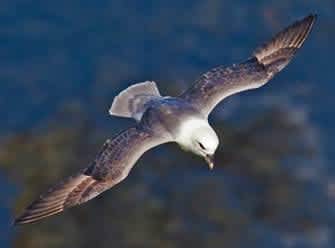New Study Finds that Bird Ingestion of Plastic in U.S./Canadian North Pacific Among Highest in the World
OutdoorHub 07.18.12

A new study by U.S. and Canadian scientists has found that seabirds may be eating much more plastic trash than they have in the past, and that seabirds studied off the coast of Washington State and British Columbia are ingesting plastic at rates that are “among the highest” in the world.
The report, soon-to-be published in the Marine Pollution Bulletin, was authored by Stephanie Avery-Gomm of the University of British Columbia and five other researchers (see list at end of release). The study was carried out in 2009 – 2010 and involved the analysis of 67 Northern Fulmars that washed up dead on the shores between Long Beach, Washington, and Vancouver Island, British Columbia.
Northern Fulmars, gull-like petrels related to albatrosses and shearwaters, are particularly suitable to study when considering trends in plastic pollution because they forage almost exclusively at sea, have vast ranges and because they will forage almost anything from the surface of the water.
“The results are troubling. The large amount of plastic ingested by fulmars from the eastern North Pacific are approaching the high levels which have been documented previously in the historically polluted North Sea, where fulmars have been used as an indicator species of ocean health for decades. In addition, it is safe to say, based on earlier studies from the North Pacific, plastic ingestion in Northern Fulmars, and therefore plastic pollution, has increased in the North Pacific over the past forty years,” said Avery-Gomm.
“The science on this issue is still being refined – there is much we don’t know about the impacts of plastic ingestion on birds in general and Northern Fulmars in particular. We do know that the plastic in the stomach displaces the space for food that the birds need and that plastic can lacerate the stomach lining. Some of the birds we looked at had their gizzards completely full with plastic. We also know that plastic in the sea absorbs an astounding level of contaminants in a very short time and that these contaminants may leach out in a bird that swallows it,” said Avery-Gomm.
The researchers found that the dead birds had ingested an average of 0.385 grams of plastic in the 2009/2010 study, compared to 0.12 grams in a 1987 study and 0.04 grams in a 1969 -1977 study. The incidence of plastic ingestion is also on an upward trend. A 1968-1977 study found that 57.9 percent of the studied fulmars had ingested plastic, compared to 84.2 percent in 1988-1989 and 92.5 percent in 2009-2010.
“We have known about this problem for 40 years and not only have we failed to do anything about it, it has actually gotten worse,” said Dr. George Wallace, Vice President for Oceans and Islands at American Bird Conservancy, a leading U.S. bird conservation organization. “Two things are for certain – one, this problem is not going to go away on its own – it will get worse; and two, developing ways to slow or stop the flow of plastics into the oceans will only get more expensive the longer we wait.”
Of the 67 birds studied, 32 were males; 33 females and 2 were of unknown sex. The age ratio was 24 adults; 33 juveniles and 10 of unknown age. Thirty-six birds were collected on the west coast of Vancouver Island and 31 were collected on beaches in Oregon and Washington. Over 95 percent of the ingested plastic consisted of twine, rope, fishing line, Styrofoam, hard pieces of discarded plastic (e.g., bottled caps), fiber sponge, and sheet plastic.
Co-authors of the study were Patrick D. O’Hara of Environment Canada-Canadian Wildlife Service, c/o Institute of Ocean Services; Lydia Kleine of the Slater Museum of Natural History, University of Puget Sound; Victoria Bowes of the BC Ministry of Agriculture Animal Health Center; Laurie K. Wilson of Environment Canada-Canadian Wildlife Service; and Karen L. Barry of Bird Studies Canada.

